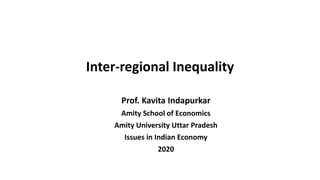
Lecture 2-Inter-regional Inequality (1).pptx
- 1. Prof. Kavita Indapurkar Amity School of Economics Amity University Uttar Pradesh Issues in Indian Economy 2020 Inter-regional Inequality
- 2. Regional Imbalances-Definition • Regional imbalances or disparities means wide differences in per capita income, literacy rates, health and education services, levels of industrialization, infrastructural facilities etc. between different regions. Regions may be either States or regions within a State. • “Balanced regional development is the economic development of all regions simultaneously, raising their per capita income and living standards by exploiting their natural and human resources fully”. The policy of balanced regional development is considered on both
- 3. Global Theories of Regional Disparities • The Neo-Classical Theory of Convergence: The neo- classical school is a believer in market forces and flexible prices. Its perspective on regional developmental disparities is drawn from Solow’s growth model. One implication on Solow’s growth model is that the countries with different levels of per capita income over time tend to converge to one level of per capita income. The conclusion is based on the assumption that output per labour is subject to diminishing returns to capital per labour. By this assumption in developed countries with higher capital per labour, per capita income tends to grow at a slow rate than in developing countries which
- 4. • Gunnar Myrdal Theory: He argues that due to industrialization and gain in productivity, rich regions benefit more. He does not deny that growth spreads to poor regions through access to larger markets and trade opportunities. However, he insists that gains are offset by stronger backwash effects generated by deteriorating terms of trade resulting from high productivity gains in industrialization in rich regions. Therefore, the theory predicts divergence in regional incomes. Myrdal’s and Krugman analysis also resonant with Hirschman’s theory of unbalanced growth.
- 5. • Theory of Unbalanced Growth: Unbalanced growth is a natural path of economic development. Situations that countries are in at any one point in time reflect their previous investment decisions and development. Unbalanced investment can complement or correct existing imbalances. Once such an investment is made, a new imbalance is likely to appear, requiring further compensating investments. Therefore, growth need not take place in a balanced way.
- 6. • Resource Curse Theory: Negative correlation between resource abundance and economic growth is called the resource curse. It was formally presented by Auty in 1993. For example: Japan relatively having less natural resources compare to India developed faster.
- 7. Types of Regional Disparities in India Types of Disparities/Imbalances: They are: • Global Disparity (Disparity between Nations) • Inter-State Disparity (Disparity between States) • Intra-State Disparity (Disparity within States) • Rural-Urban Disparity (Disparity between Rural & Urban)
- 8. Indicators and Measures of Regional Disparity • Population growth - Population growth is an important indicator of Regional Disparity as in the table we have top five populous states and bottom five states with their % contribution in countries total population, it shows that major portion of our human resources potential is concentrated in northern belt of country.
- 9. • Economic Growth - Gross State Domestic Product & Per capita Income. Among the top GSDP states UP, Andhra Pradesh have low per capita which indicates the disparity in distribution of income among people. Where as the states like Kerala, Haryana, Uttarakhand have low GSDP but, their distribution of income among people is quite even. In bottom five GSDP states, the income distribution is much more uniform than in top GSDP States, it can be because of many reasons like efficient administration, small population, resource management etc.
- 10. • Infrastructural – Transportation, power infrastructure, energy distribution etc. Indicators of transport infrastructure availability across regions in India are railway network density, Road network density, length of national and state highways in the state.
- 11. • Socio- Economic Disparity – we can measure socio- economic disparity among states through Human Development Index HDI. HDI includes per capita income, life expectancy rate, mean year of schooling and school life expectancy are the basic indicators of socio- economic status of any state or region. Other than Kerala and Delhi the per capita income is low in the top ranking HDI states and the distribution of health and education facilities in bottom ranking states is poor due to many political, geographical, administrative reasons.
- 12. • Foreign Direct Investment: • High FDI States: Maharashtra, Dadra nagar Haveli, Daman & Div, Delhi, Haryana, Tamilnadu, Pondicherry, Karnataka, Gujarat, Andhra Pradesh. Medium FDI States: West Bengal, Sikkim, Andaman & Nikobar islands, Rajasthan, Chandhighadh, Punjab, Haryana, Himachal Pradesh, Madhya Pradesh, Chatiishghadh, Kerala, Lakshadweep. • Low FDI States: Goa, Orissa, UP, Uttaranchal, Assam, Arunachal Pradesh, Manipur, Meghalaya, Mizoram, Nagaland, Tripura, Bihar and Jharkhand.
- 13. Causes of Regional Imbalances in India • 1. Historical factors: British regime • 2. Geographical factors : Natural factors • 3. Failure of planning: Although balanced growth has been accepted as one of the major objectives of economic planning in India, since the second plan on wards, but it did not make much headway in achieving this object. • 4. Financial: Small and Medium enterprises which are important engine of growth and productivity have not been able to access finance in rural areas. • 5. Infrastructure: • 6. Disparities in Socio-Economic Development: • 7. Political : • 8. Predominance of Agriculture: • 9. Lack of Motivation on the Part of Backward States: • 10. Locational Advantages:
- 14. Consequences of Regional Imbalances in India • Inter-States and Intra-State Agitations • Migration • Social Unrest • Pollution • Housing & Water Pollution • Frustration Among Rural Youth • Under-Developed Infrastructure • Aggregation of the Imbalance